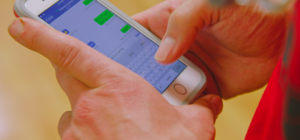Contacting a coworker should be an easy thing. You open your phone, Find the right person and call them. For clinicians, this isn’t so straightforward. In my research into clinical communication workflows, I have found that clinicians often have a difficult time locating and contacting the colleague they need.
Most of these workflows look a little like this: A nurse needs to confirm a medication order with the patient’s physician. There’s only one problem—she doesn’t know the physician’s name. Perhaps the patient’s care team is written on a whiteboard over the bed. She asks the unit secretary to find the contact information for that physician. The unit secretary finds the information and calls the physician’s office number, but the physician is busy. The unit secretary leaves a message and everyone waits.
Anyone who has worked in a hospital is likely familiar with this workflow. It can take 15 minutes or longer just to get a simple order confirmation. Multiply this by the number of patients a nurse will work with over the course of a single shift and you can see how quickly this kind of delay adds up to hours of care time wasted.
Evaluating the Modern Hospital Directory
So, what’s the solution? As a Senior Product Manager at Mobile Heartbeat, I’ve worked with clinical leadership and end users to better understand the areas that are limiting this workflow efficiency. I’ve found that, for this problem, it’s necessary to start right at the source: the directory.
The directory within a communication platform often seems straightforward: It is a repository of contacts, including name, phone numbers and sometimes additional information like roles, units and facilities. Using a search feature in a directory is as simple as tapping a magnifying glass icon and typing a name.
But this doesn’t exactly provide the flexibility that many healthcare workers need. It’s not uncommon—in fact, it’s quite normal—for a nurse or physician or specialist to not know the name of the person they’re trying to track down. For this reason, one attribute that needs to be searchable is role. Chances are good that, if a clinician doesn’t know the name of the person they’re looking for, they at least know what their role is.
Alternatively, they may only know which patient they’re assigned. Or perhaps a clinician needs to send a group text to everyone in a specific unit. There are plenty of situations where healthcare workers will urgently need to reach coworkers with very limited information about the recipient.
Building a Dynamic, Flexible Directory
The clear path forward is a directory that allows users to search contacts by any known attribute. What does this mean? The directory should be populated with as much relevant contact information as possible, including common work locations, frequent on-call roles, provider group and more.
With all of this information present and searchable in the directory, clinicians can use any and all of the following attributes to reach the right recipient:
- Name
- Role
- Specialty
- Facility
- Unit(s)
- On-Call Assignment
- Number
- Provider Group
With all of these searchable attributes, clinicians will be able to cut out the unit secretary as a middleman and find the person they’re looking for, no matter how much or how little information they have. A medication order that would have taken 15 minutes or longer to receive now takes 15 seconds.
Alternative Ways to Locate Colleagues
In addition to providing a robust and real-time directory for our users, we have added additional ways to help them quickly reach the right clinician.
The first is the ability to favorite contacts. This is pretty straightforward: If a nurse is frequently collaborating with a physician, they are able to favorite each other’s contact information for quick and easy access at any time. In this same vein, our My Units functionality allows nurses and other users to view a contact’s unit assignment for added flexibility in reaching a colleague.
Finally, users can leverage our patient module to search for colleagues by assigned patient. This is a great capability for when users need to quickly find someone on the patient’s care team. The information is pulled directly from your organization’s EHR and staff assignment modules from the nurse call system, so it’s always up to date. The capability, which we call Dynamic Care Team, allows physicians and nurses to easily identify any specialists on the patient’s care team to improve care coordination.
There’s no reason it should be difficult for clinical staff to track down colleagues, especially during emergent situations. For more information on how we ease these common workflow challenges for users, contact us here.





